|
|
AYUTTHAYA
Ayutthaya, 76 kilometres north of Bangkok, was
the Thai capital from 1350 until 1767, when the
city was virtually destroyed by Burmese invaders.
Ruined palaces and temples attest to the riverine
island city's former grandeur. Indeed, during
its zenith in the mid-1600s, Ayutthaya was a truly
cosmopolitan city, and the major power in Southeast
Asia. Ayutthaya province covers some 2,556 square
kilometres, and contains several attractions connected
mainly with Thai royalty, past and present.
HISTORY
The Kingdom of Ayutthaya was built and developed
in leaps and bounds. The ruins in Ayutthaya that
survived the test of time embody both the glorious
and ignominious stories of the Kingdom.
This ancient capital of the Kingdom of Ayutthaya,
founded in 1350 by King U-Thong, had thirty three
kings of different dynasties and reached its
peak in the middle of the18th century. A magnificent
city with three palaces and over 400 magnificent
temples on an island threaded by canals Ayutthaya
was truly an impressive city that attracted both
Europeans and Asians. After a 15-month siege
the Kingdom of Ayutthaya was conquered and completely
destroyed by the Burmese in 1767. When King Taksin
the Great finally liberated the Kingdom, a new
dynasty was established and the capital was moved
to Thonburi.
The seal of Ayutthaya depicts a conch on a pedestal
tray placed in a small castle under a Mun tree.
According to legend, King U-Thong, founder of
the Kingdom of Ayutthaya, discovered a beautiful
conch buried in the ground being prepared for
the establishment of the seat of his Kingdom.
Consequently, he had a tiny castle built to house
the shell. Hence, the provincial seal.
CITY ATTRACTIONS
TEMPLES, PALACES & MUSEUMS
Wat Phra Si San Phet
This royal temple was the inspiration for the
Emerald Buddha Chapel in Bangkok, and is the focal
point of a complex currently called the 'Ancient
Palace'. Much like the Grand Palace complex in
Bangkok, the 'Ancient Palace' was the traditional
residence of Ayutthayan monarchs. The entire complex
is dominated by Wat Phra Si San Phet's three towering
Ayutthayan-style chedis, and contains several
satellite ruins of meeting halls used for state
ceremonies, to welcome foreign envoys, to view
military parades and royal barge processions,
and for leisure. Adjacent to the complex is the
Phra Mongkhon Bophit Chapel which houses a massive
bronze Buddha image. Wat Phra Ram This temple
was constructed during the late 1300s by King
Ramesuan to commemorate his father, King Ramathibodi
I, who founded Ayutthaya as his new capital in
1350.
Wat Ratchaburana
Located opposite Wat Mahathat, this temple was
built by King Borom Rachathirat II during the
1420s.
Wat Mahathat
Dating from the late 1300s, this extensive temple
was destroyed in 1767. Golden memorabilia from
the temple is displayed in the Chao Sam Phraya
National Museum.
Wat Suwandaram Ratchaworawihan
This temple, noteworthy for excellent murals in
the main classsic Ayutthayan-style chapel, near
the Pom Phet fortress, is a royal monastery of
the present Chakri dynasty.
Wat Suanluang Sopsawan
This riverside monastery was built during the
mid-1500s, and contains the Queen Sisuriyothai
Memorial Chedi honouring the Ayutthayan heroine,
Queen Sisuriyothai, who sacrificed her life, during
elephant-back combat, repelling Burmese invaders
in 1548, to save her husband. A statue of the
queen astride a war elephant dominates the Queen
Sisuriyothai Memorial Park on the city outskirts.
Wat Lokayasutharam
This temple is noteworthy for a long brick and
plaster reclining Buddha image some 29 metres
in length. Wat Phuttaisawan This riverside temple
was constructed in the area where King U-Thong
(later crowned King Ramathibodi I) and his followers
founded the new capital of Ayutthaya in 1350.
Wat Chaiwattanaram Another riverside temple built
by King Prasat Thong during the 1600s. The main
prang and pagodas remain in good condition. Wat
Na Phramen This temple, still in use today, is
the only temple not completely destroyed during
the 1767 invasion and destruction of Ayutthaya.
Wat Phananchoeng
This riverside temple pre-dates Ayutthaya's founding
as the Siamese capital in 1350. The principal
Buddha image was built in 1325 and is highly revered
by local inhabitants.
Wat Phukhao Thong (Golden Mount)
Located two kilometres northwest of the Wat Phra
Si San Phet complex, this temple was constructed
in 1387 during the reign of King Ramesuan.
Wat
Yai Chaiyamongkhon
This monastery dates from
the mid-1300s, The enormous pagoda was built
by King Naresuan the Great to celebrate his victory
in 1592 over the Burmese Crown Prince in single-handed
combat on elephants.
Chanthrakasem or Front Palace
Located on the bank of the Pasak river, this
palace was built as the residence of King
Naresuan the Great (reign: 1590-1605).
The palace was renovated during the mid 1800s
by King
Mongkut (Rama IV) to be his residence
during occasional visits to Ayutthaya. The palace
is now part of the National Museum under the
responsibility of the Fine Arts Department.
The
museum is open every day, except Monday, Tuesday
and national holidays, between 9.00 AM and 4.00
PM.
Admission: 10 baht.
Chao Sam Phraya National
Museum
The museum contains many Ayutthayanstyle
objets d'art, including exquisite golden royal
memorabilia excavated from local temples.
The
museum is open every day, except Monday, Tuesday
and national holidays, between 9.00 AM and 4.00
PM.
Admission: 10 baht.
Ayutthaya Historical
Study Centre
Located diagonally opposite the
Chao Sam Phraya National Museum, this centre
is a national research institute devoted to the
study of medieval Ayutthaya. The centre contains
reconstructions from Ayutthaya's historical past,
an information service and a library.
The centre
is open from 9.00 AM until 4.00 PM every day,
except Mondays, Tuesdays and national holidays.
Admission: 100 baht.
Khun Phaen's Residence
This
teak traditional Thai-style residence, as
might have been owned by a wealthy merchant,
located near the Phra Mongkhon Bophit Chapel,
evokes a bygone era's lifestyle.
Elephant
Kraal
This unique teak and brick structure,
just beyond Ayutthaya's riverine island, was
formerly used to entrap wild elephants herded
down from the North. Such occurrences were
traditionally presided over by Thailand's
best-known landmarks. Originally built of
wood during the reign of King Rama V, the
structure was reinforced with concrete pillars
and floor by his son, King
Vajiravudh (reign:
1910-1926).
Warophat Phiman Hall
Formerly
a wooden, two-storey building used as a throne
hall, and royal residence, the present European-style
throne hall was constructed by King Rama
V. The hall contains several historical paintings,
and some of popular Thai literature, including
the epic Ramakian, and Inao.
Utthayan Phumisathian
Hall
The current wooden structure is a faithful
reproduction of the original, which burned
down in 1938.
Wehat Chamrun Hall
This magnificent
Chinese-style building was a gift to King
Chulalongkorn (Rama V) from the king's subjects
of Chinese ancestry. King Rama V used customarily
to reside in the dwelling during Cool Season
visits.
Withunthatsana Hall
The tower-like
structure, essentially a three-storey-building
with a spiral staircase, was used by King
Rama V as a vantage point during his periodic
visits.
Queen Sunantha Monument
This memorial
to the consort of Rama V who died tragically
during a boating accident at Bang Pa-In contains
the queen's ashes and relics.
Wat Niwet Thammaprawat
This riverine island Buddhist temple was constructed,
at the command of King Rama V during 1878,
in the style of an English Gothic church.
The structure's stained glass windows and
unusual architecture make it one of the most
distinctive Buddhist temples anywhere in Thailand.
Bang Sai Royal Folk Arts & Crafts
Centre
This 14-acre riverside complex in Ayutthaya's
Bang Sai district is under the Foundation
of Supplementary Occupations and Related Techniques
(SUPPORT) which was established under royal
patron- Ayutthayan monarchs, partly because
the mighty beasts were vital to Ayutthaya's
military strength.
Out-of-City Attractions
Prasat Nakhon Luang
This imposing riverside
structure in Amphoe Nakhon Luang was used
as royal accommodation by late Ayutthaya-period
monarchs during trips to Lop Buri and the
Buddha's Footprint Shrine in Saraburi.
Bang
Pa-In Summer Palace
Half an hour south of
Ayutthaya, (58 kilometres north of Bangkok
by rail, 61 kilometres by road), Bang Pa-In
is the site of a riverside summer palace formerly
popular with late Ayutthaya-period monarchs
and early kings of the present Chakri dynasty.
Originally, the riverine island was used by
the Ayutthayan monarch, Prasat Thong (reign:
1630-1655) as a summer residence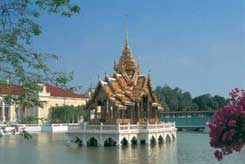 , and by every
Ayutthayan monarch thereafter. , and by every
Ayutthayan monarch thereafter.
When Bangkok
became the new Thai capital in 1782, Bang
Pa-In remained deserted for 80 years. King
Rama IV (reign: 1851-1868) stayed there and
had a residence constructed in the old palace
compound. His son, King
Chulalongkorn (reign:
1868-1910) liked the place, and stayed there
every year, largely constructing the royal
palace, a collection of Thai, European and
Chinese-style buildings, as it is seen today.
The palace is open every day from 8.30 AM
until 3.30 PM. Admission is 50 baht.
Major
palace buildings include: Aisawan
Tippaya Asna Pavilion 
This lovely classic Thai-style pavilion
in the centre of an ornamental lake is one
of age during 1976.
The Bang Sai Folk Arts
and Crafts Centre
The centre trains
farmers from Ayutthaya, and other provinces,
in folk arts and crafts. Visitors to the
centre can see how such crafts are produced.
They include: Fern vine basketry Basketry weaving Artificial
silk flowers Hand-woven silks and cottons Silk dyeing
Wood carving Miniature hand-made Thai dolls Furniture
making Textile products.
All such products are sold
at the Bang Sai Centre, and in every branch of Chitralada
Shops nationwide.
It is open every
day from 8.30 AM until 4.30 PM.
There are
no demonstrations on Monday. Admission
is 20 baht.
Bang Sai can be conveniently
reached by public transport from the Northern
Bus Terminal on Bangkok's Phaholyothin
Road. Buses depart every 30 minutes from
5.30 AM until 6.00 PM.
Tickets are 25 baht
by airconditioned bus, and 17 baht by ordinary
buses.
The Royal Folk Arts and Crafts Centre
This
is a place where visitors can see the activities
of farmers in the 4 regions of Thailand. It
covers an area of 285 rai of land (or 14 acres)
and in addition to being an important training
center for craftspeople, there are interesting
products on sale such as fern basketry, wickerwork
basketry, artificial flowers, hand-woven silk
and cotton, silk production and etc.
The Royal
Folk Arts and Crafts Centre is open daily except
Mondays from 8.30 a.m. to 4.00 p.m.
Admission
fee is 20 bahts. Call 035-366092, 02-2258265
(Bangkok) for additional information.
Major Events & Festivals
Bang Sai Arts & Crafts Fair
Each January,
the Royal Arts & Crafts Centre features handicrafts
exhibitions and demonstrations and traditional
folk entertainment performances.
Songkran Festival
Traditional Thai New Year celebrations, each
April 13, in front of the Phra Mongkhon Bophit
Chapel, include religious merit-making and public
merriment, largely in the form of good-natured
water throwing.
Bang Sai Loi Krathong (Festival
of Lights) &
Boat Races
Each November, the Centre hosts traditional
Loi Krathong celebrations, including floating
away krathongs under the full moon, beauty contests,
handicrafts demonstrations and exhibitions, long
boat races, and special events.
Ayutthaya World
Heritage Site Celebrations
Each December, Ayutthaya
celebrates its UNESCO-designation as a World
Heritage Site with light and sound presentations,
historical cultural processions and performances
and folk entertainment within the Ayutthaya Historical
Park.
How To Get There:
By Train to Ayutthaya
Trains leave
Bangkok's Hualampong Railway Station (Tel:
223-7010, 223-7020 for timetables and fares),
daily, every hour, from 4.30 AM until 11.25
PM. The trip takes 80 minutes to Bang Pa-In,
and 90 minutes to Ayutthaya.
By Bus to Ayutthaya
Direct
Bangkok-Ayutthaya airconditoned buses leave
Bangkok's Northern Bus Terminal on Phaholyothin
Road (Tel: 272-5299, 292-5242 for fares
and further details) every 30 minutes between
6.00 AM and 7.00 PM.
The trip takes 90
minutes. Nonairconditioned buses make the
same trip in approximately 1 hour and 40
minutes.
By River to Ayutthaya
Certain Bangkok operatorsoffer daily river
cruises to and from Bang Pa-In with return
journeys by coach.
Details of current trips and fares may
be obtained from TAT offices in Bangkok
and Ayutthaya.
Transportation in Ayutthaya
Mini-buses can be
taken from the railway station into town. Fares
are approximately 5 baht per person.
Ferries
can be taken from the pier near the railway station
across the Pasak River. The fare is 2 baht.
Hiring
a mini-bus or tuk-tuk (3-wheeled vehicle) within
Ayutthaya costs from 300 to 500 baht per day.
Bicycles can be rented for about 50 baht per
day.
Accommodation in Ayutthaya
A comprehensive list of airconditioned
and non-airconditioned accommodation, and restaurants,
in Ayutthaya can be obtained from the local Tourism
Authority of Thailand office on Si San Phet Road.
The office is open seven days a week, throughout
the year, from 8.30 AM until 4.30 PM.
|

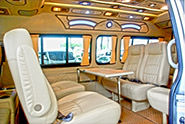
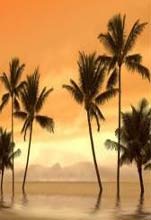
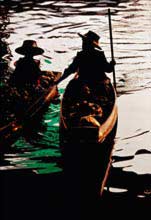
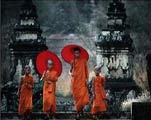

 , and by every
Ayutthayan monarch thereafter.
, and by every
Ayutthayan monarch thereafter. 




